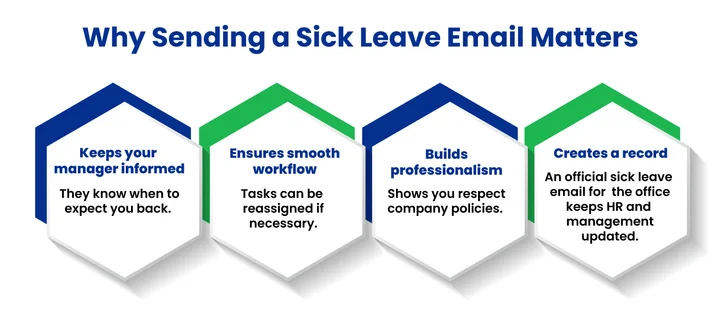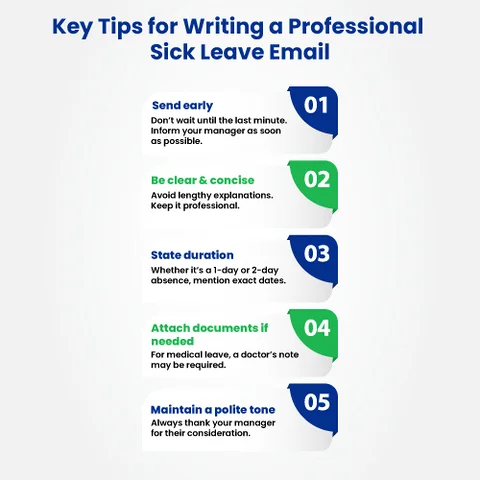Taking time off from work due to illness is sometimes unavoidable, but informing your manager in a professional and timely manner is just as important as taking the time to rest. According to the U.S. Bureau of Labor Statistics, around 81% of civilian workers are entitled to paid sick leave benefits.
However, a well-written sick leave email ensures that your employer understands your situation, can plan around your absence, and sees you as responsible and considerate.
In this blog, we will discuss why a sick leave email matters, its ideal format, samples for different scenarios (1-day, 2-day, and medical leave), and the best practices for writing professional sick leave.
So, let’s get started.
Why Sending a Sick Leave Email Matters?
Notifying your team with a sick day email is a professional courtesy that ensures your absence doesn’t catch them off guard. It allows colleagues and managers to adjust schedules, redistribute tasks, and keep workflow steady even when you’re away.
There are two common situations where sending a sick day email is appropriate:
1. When You’re Physically Unwell
If you’re too ill to perform your duties, staying home is often the best choice. Rest not only helps you recover faster but also prevents the spread of contagious illnesses like the flu. Even non-contagious health issues, such as migraines, severe body pain, or exhaustion, can make it impractical to work effectively.
2. When You Need a Mental Health Break
Mental health is just as important as physical well-being. If you’re overwhelmed, stressed, or mentally drained, taking a day to recharge can help you return with better focus and productivity.
In other cases, such as emergencies, family obligations, or personal matters, you may need time off that isn’t health-related. In those situations, a different type of email should be used to explain your absence.
However, workplaces rely on effective communication. When you’re unwell, a sick leave request email serves multiple purposes:
How do Sick Leave Emails Maintain Workplace Professionalism?
Sending a sick leave email is more than just a formality; it ensures transparency, keeps workflows uninterrupted, and shows respect for your manager’s planning needs.
Let’s find out why taking the time to write a proper sick leave email truly matters.

Don’t let sick leave requests or HR updates land in spam. Use an email verification service to ensure every important message gets delivered.
How to Write a Sick Leave Email?
To learn practical examples, it’s important first to understand the standard sick leave email format, as this ensures your message is professional, clear, and aligned with workplace expectations.
1. Subject Line
Clear and direct. Examples:
- Sick Leave Request – [Your Name]
- Medical Leave Email – [Your Name]
2. Salutation
Address your manager or HR formally:
- Dear [Manager’s Name],
- Hello [Manager’s Name],
3. Opening Line
State the reason for your email:
- I am feeling unwell and need to take sick leave…
4. Duration of Leave
Specify dates clearly:
- I will be away on [date] and plan to return on [date].
5. Work Handover
Mention if you have delegated tasks:
- I have updated [colleague’s name] about pending tasks.
6. Closing & Contact Information
End politely:
- Thank you for your understanding.
- Provide a way to be reached in case of an urgent matter.
7. Signature
Use your professional email signature or simply write:
- Best regards, [Your Full Name]
This formal sick leave email format is suitable for both short and extended leave requests.
Miscommunication during leave requests can disrupt workflow. Protect your company’s communication with smart verification.
Best Practices for Writing a Sick Leave Email
A short sick leave email to your boss for a single day or a medical leave request with a doctor’s note for extended time off both require proper structure to be effective.
To make your message effective, follow the professional email templates to ensure clarity, maintain workplace professionalism, and help your manager or HR handle your absence smoothly.

Below are practical sick leave email examples you can use depending on your situation. These ready-to-use templates will help you communicate your absence clearly, maintain professionalism, and ensure your manager and HR are properly informed.
1. Sick Leave Email for 1 Day
This is the simplest email for sick leave, 1 day, short, polite, and professional. It’s ideal for a one-day absence when you don’t need to go into detail but still want to keep your manager informed and maintain workplace professionalism.
Sample 1
Subject: Sick Leave Request – [Your Name]
Dear [Manager’s Name],
I am feeling unwell and would like to request sick leave for one day on [date]. I expect to return to work the following day, [date].
Please let me know if any additional information is required.
Thank you for your understanding.
Best regards,
[Your Name]
Sample 2
Subject: Sick Leave Request for [Date]
Dear [Manager’s Name],
I am feeling unwell and would like to request sick leave for [date]. I will be available by phone if needed for any urgent matters.
Thank you for your understanding.
Best regards,
[Your Name]
Sample 3
Subject: Request for Sick Leave on [Date]
Dear [Manager’s Name],
I have come down with a fever and cold and would like to take a day off on [date] to rest and recover. I will be sure to catch up on any pending work once I return.
Sincerely,
[Your Name]
Sample 4
Same-Day Sick Leave
Subject: Sick Leave for Today [Date]
Dear [Manager’s Name],
I am not feeling well this morning and will be unable to attend work today, [date]. I apologize for the short notice and appreciate your understanding.
Kind regards,
[Your Name]
2. 2-Day Sick Leave Email Sample
This 2-day sick leave email sample includes a handover note, ensuring your responsibilities are covered while you’re away, a thoughtful approach that is often valued in professional settings.
Sample 1
Subject: Sick Leave Notification – [Your Name]
Dear [Manager’s Name],
I am experiencing health issues and request two days of sick leave from [start date] to [end date]. I will resume work on [return date].
I have updated [colleague’s name] about urgent tasks to ensure a smooth workflow during my absence.
Thank you for your support.
Sincerely,
[Your Name]
Sample 2
Subject: Sick Leave Request for [Dates]
Dear [Manager’s Name],
I have developed a high fever and would like to request sick leave on [start date] and [end date]. Please let me know if you require a medical note.
Best regards,
[Your Name]
Sample 3
Subject: Request for 2-Day Sick Leave
Dear [Manager’s Name],
I am feeling unwell and need two days of rest from [start date] to [end date]. I will ensure all urgent tasks are updated before resuming work.
Sincerely,
[Your Name]
Sample 4
Subject: Sick Leave Request (X Days)
Dear [Manager’s Name],
I am experiencing health issues and kindly request sick leave for three days, from [start date] to [end date]. I appreciate your understanding and support.
Thank you,
[Your Name]
3. Medical Leave Email to Manager With Doctor’s Note
These medical leave email samples include a doctor’s note, adding formal validation to your request and ensuring transparency with your manager.
Sample 1
Subject: Request for Medical Leave – [Your Name]
Dear [Manager’s Name],
I have been advised by my doctor to take medical rest due to [brief reason, e.g., flu, surgery]. Therefore, I would like to request medical leave from [start date] to [end date].
Attached is my doctor’s note for your reference. Please let me know if any further documentation is needed.
I appreciate your understanding and support.
Best regards,
[Your Name]
Sample 2
Subject: Request for Medical Leave
Dear [Manager’s Name],
On my doctor’s recommendation, I need to take medical leave from [start date] to [end date]. I have attached the medical certificate for your reference. Please let me know if you need any additional details.
Kind regards,
[Your Name]
Sample 3
Subject: Medical Leave Request with Documentation
Dear [Manager’s Name],
I will be undergoing [surgery/procedure] and need medical leave starting from [start date]. My doctor has advised a recovery period of [X weeks/days]. I will stay in touch and provide updates on my return.
Sincerely,
[Your Name]
Sample 4
Subject: Extended Medical Leave Request
Dear [Manager’s Name],
Due to a health condition, I request medical leave from [start date] to [end date]. I will hand over my responsibilities before my leave begins and provide HR with the required medical documents.
Thank you for your support.
Best regards,
[Your Name]
This medical leave email format is essential when company or HR policies require official documentation, such as a doctor’s note, to validate your extended absence.
In a nutshell, always send a sick leave email request as soon as possible, follow a professional leave email format for clarity, use polite, concise language, specify dates for longer absences, and provide a medical leave email to the manager with supporting documents. Last but not least, keep records for HR purposes by sending a formal leave application email to the manager.
Wrapping Up
Writing a sick leave email for the office doesn’t have to be complicated. Short 1-day emails, extended leave requests, and formal medical notes all rely on clarity, professionalism, and timely communication.
When you apply the examples and best practices above, your absence will be handled efficiently and your professionalism maintained. If you want to make sure your important emails, like leave requests, always reach the right inbox, consider using email verification services to keep your communication reliable.
Frequently Asked Questions(FAQs)
What Is The Best Sick Leave Email To the Manager With a Reason?
The best sick leave email to a manager includes a clear reason for absence, the duration of leave, and reassurance about work continuity. For example: “I have come down with the flu and will need two days off to recover. I will update you if I need more time and will ensure pending tasks are delegated.”
How To Write A Short Sick Leave Email To the Boss?
A short email should be polite and direct. Keep it to one or two sentences: “I am not feeling well and will be taking the day off. Thank you for your understanding.” This format works well for brief, unplanned absences.
How To Write A Sick Leave Email With A Doctor’s Note?
When HR or company policy requires documentation, attach the doctor’s note to your email. In the body of the email, state the medical recommendation and duration of leave. Example: “As per my doctor’s advice, I will need to take medical leave from [start date] to [end date]. I have attached the doctor’s note for reference.”
How To Write A Professional Sick Leave Email To HR?
A professional email to HR should be formal and comply with policy. Include your name, position, reason for absence, dates, and any required documents. For instance: “I am requesting sick leave from [start date] to [end date] due to [reason]. Please find my doctor’s note attached. Kindly confirm the approval of this leave.”
Should You Attach a Doctor’s Note While Requesting Sick leave from the office?
If you’re on extended medical leave or company policy requires it, yes. A sick leave email with a doctor’s note sample is appropriate.
A bounced email could delay your approval. Confirm your manager’s email is valid before hitting send.
Leave a Reply